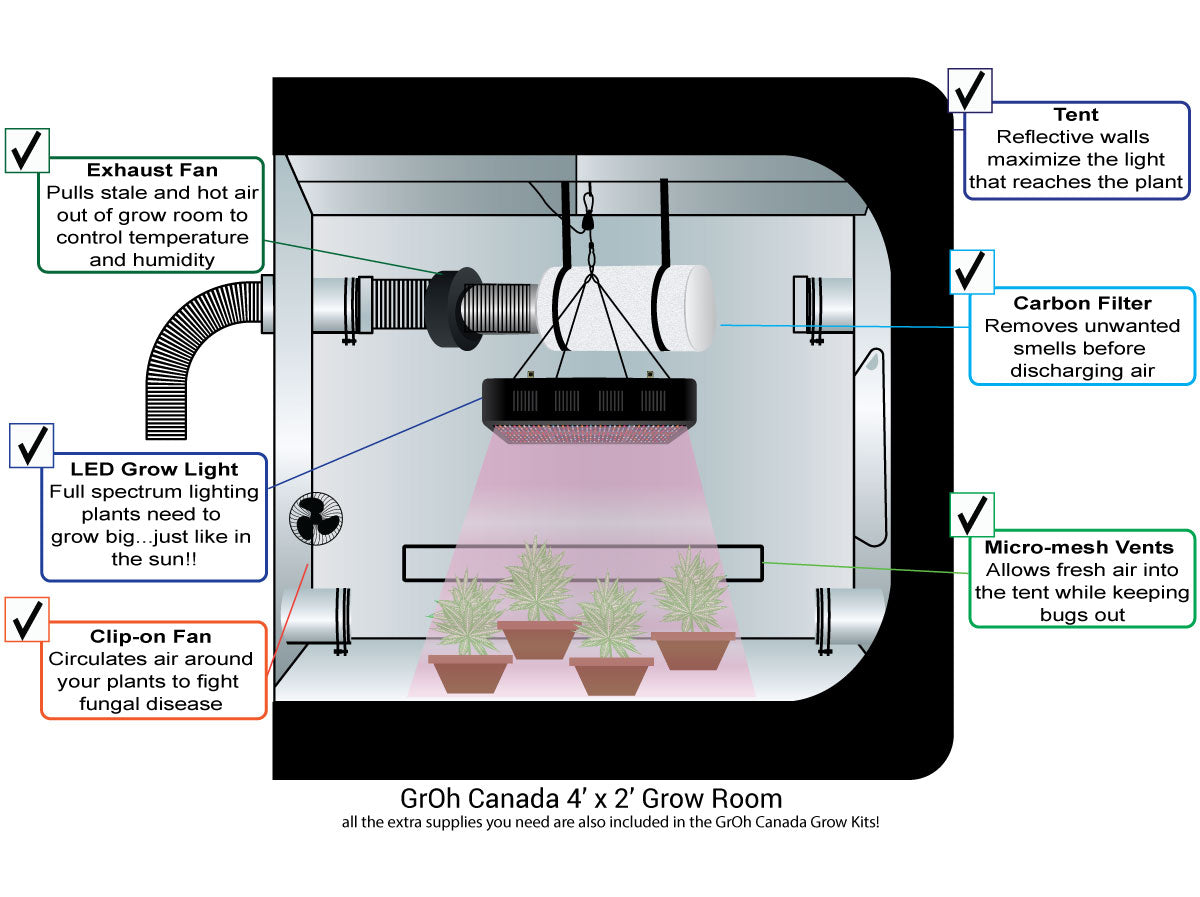Your Cart is Empty

To start growing indoors, your grow room setup can be very simple and inexpensive, or you can outfit every detail to be as efficient and convenient as possible.
Below we explain what you need to set up a grow room of your own, with options to take you from basic to fully outfitted.
Outdoor plants get the full spectrum of light, ultraviolet to infrared, from the sun. Inside, you need lights that mimic the sun’s range. Fluorescent and incandescent bulbs do not cover enough of the light spectrum to grow mature plants through to flowering. You need high-intensity discharge (HID) lights or a set of light-emitting diode (LED) fixtures.
Good: Metal halide lighting is strong in the blue range of the spectrum, the type of light that plants need for growing a canopy of branches and leaves during the vegetative stage of the plants lifecycle. High-pressure sodium emits more light in the red end of the range, vital to vigorous blooming during the flowering stage.
Best: You can successfully grow plants indoors with either type of lighting, but it is ideal is to have lights that cater to both stages to enable maximum vegetating, and maximum flowering. LED Grow Lights generally offer both ranges of the spectrum so you just need a single light throughout your grow. Some LED lights even offer the ability to intensify the blue, or red spectrums of light even further as your plant changes stages. LED lights are more expensive to purchase but they use less power (i.e. are cheaper to run), don’t get as hot as the other types and are simpler to set up.
Tip: Set up your light so that you can adjust either the height of your plants or the lights, allowing you to keep them a healthy distance apart—not too close together, not too far away—at each stage of growth.
Fresh air brings vital oxygen and carbon dioxide to plants, and as it circulates, it reduces the risk of fungal diseases by keeping the humidity down (more on that in the next section). In an enclosed grow room it is very important to refresh, and circulate the air.
Good: Simple fans you have around the house can gently circulate air. But to take out stale air and bring in fresh air, you need extractor fans to pull out air (exhaust) and a fan (intake) or vents to allow fresh air in.
Best: Carbon dioxide is so vital to photosynthesis that enriching the natural supply can promote extraordinary plant growth. You can pump CO2 into your grow room from a tank with a regulator or from an electronic generator designed for this purpose. Having a Carbon Filter can help scrub the air before it gets expelled from your grow room to ensure that no unwanted odours escape.
Tip: Setting up a fan to blow air gently on plants not only refreshes the CO2 around them, their stems grow stronger in steady breeze.
An enclosed grow room where liquid is dripped, misted, or soaked onto plants is bound to be humid. When humidity is too high, plants become vulnerable to mold, mildew and other fungi that can ruin your crop.
Good: Air circulation is key for dispersing humidity that accumulates around the plants. Sacks of inexpensive silica gel also absorb moisture from the air.
Best: Use a hygrometer to control humidity for growing healthy, productive plants.
Tip: Be sure to keep the reservoirs for your nutrient solution covered at all times so that the liquid does not evaporate and contribute to the room’s humidity levels.
Plants grow best indoors in temperatures from 18 to 24 degrees Celsius. Cooler temps slow growth; warmer temps stress the plants and leave them vulnerable to disease. The good news is that the ideal temperature range is similar to most homes.
Good: Fresh, circulating air can prevent heat buildup from lights, especially from HID lighting which runs hot and can raise the temperature in your grow room. A grow room with a ceiling that’s taller than 6 feet leaves space above lamps for some heat to dissipate.
Best: An independent heating and cooling system for your grow room gives you total control of the temperature at all times, allowing you to turn it down when the lights are on and up when they are off. Having multiple vents and fans in your grow room can also be used to maintain the temperature at a desirable level.
Tip: For consistent, healthy growth, keep the temperature as close to even as possible between the light and dark periods.
The right surfaces in your grow room can help your efforts. Reflective walls increase the light that reaches the plant. Carpeting can trap moisture and create conditions that are hospitable to fungus.
Good: Flat white paint can reflect a lot of the light that hits it. Look for the light reflectance value (LRV) ratings on cans of paint. A concrete, linoleum, or tile floor does not hold moisture, like a rug does.
Best: Mylar sends back more than 90 percent of light—you can maximize the lighting your plant needs and control the environment by using a Grow Tent with reflective walls and floors. No need to change your home to start growing indoors.
Tip: Block windows and other sources of ambient light that can disrupt your plants’ dark period and its reproductive cycle.
Remember: Grow rooms are filled with lights, fans, pumps, and other items with a demand for electricity. It is critical that you take all precautions when setting up your grow room to reduce the risk of shocks and fire.An electrical fire in your grow room will ruin more than your crop.
znxpZsotX
sArRBUNQlpm
October 13, 2020
txeLjkmrn